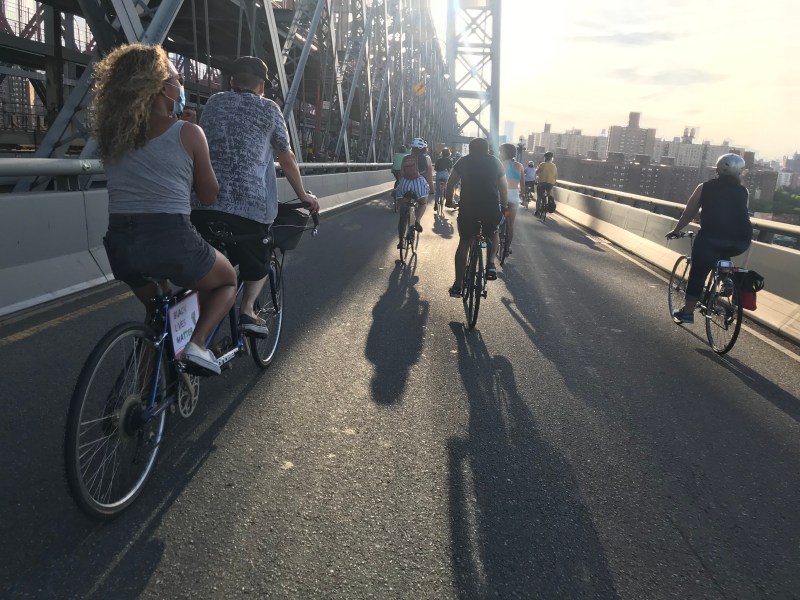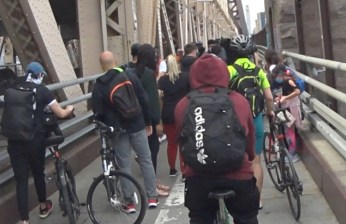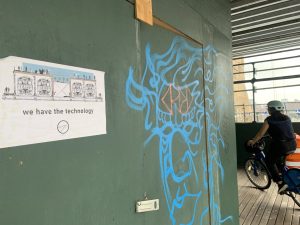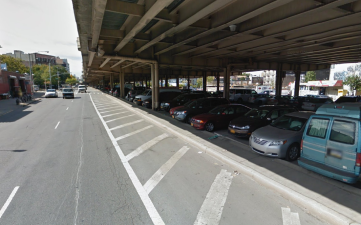Bike Advocates Kick Off Campaign for Lanes on East River Bridges
TransAlt sets sights on claiming space for cycling in the roadbed.

Activists with Transportation Alternatives launched a campaign this week to bring bike lanes to the roadbed of every East River bridge, which they say is necessary for the safety and comfort of cyclists and pedestrians as cycling burgeons on the landmark crossings.
TA’s Brooklyn activist committee is going all-in on remaking the Manhattan, Williamsburg and Brooklyn bridges with the Bridges4People campaign, the goal of which is to take two lanes of traffic from each bridge and convert them to two-way bike lanes.
“This moment requires citywide, transformative thinking, and this is a transformative campaign,” campaign volunteer Katherine Willis said. “Now more than ever we see that there’s widespread demand to bike around NYC, but the city does not have infrastructure for people to bike in large numbers. The bridges between Manhattan and Brooklyn are a particular chokepoint that stop people from biking between the two boroughs.”
The numbers, both recent and historical, support Willis’s contention. Even as the city’s economy has slowed during the coronavirus pandemic, cycling numbers over the city’s main East River bridges have climbed as local cycling has boomed. Department of Transportation stats show that the average number of cyclists traversing the three Brooklyn connections and the Queensboro Bridge rose to an average of 23,029 cyclists a day in August, a 22.37 percent rise over the 18,819 daily riders in the same month last year.
On an average weekday in August, 16,341 cyclists went over the Manhattan, Brooklyn and Williamsburg bridges, a 4.6 percent increase over 2019’s 15,621 daily cyclists.
Cycling has risen on the three Brooklyn-Manhattan crossings for decades; historical DOT data show hundreds and even thousands percentage increases in cycling on the East River bridges since 1980:
- Williamsburg Bridge 24-hour cyclist count 1980: 221
Williamsburg Bridge 24-hour cyclist count 2019: 7,089
Increase: 3,107 percent - Brooklyn Bridge 24-hour cyclist count 1980: 866
Brooklyn Bridge 24-hour cyclist count 2019: 2,558
Increase: 195 percent - Manhattan Bridge 24-hour cyclist count 2004*: 1,203
Manhattan Bridge 24-hour cyclist count 2019: 6,008
Increase: 399 percent
Meanwhile, auto traffic fell on the Brooklyn and Williamsburg bridges (although it rose on the Manhattan Bridge) from 2008 to 2018, according to the most recent bridge-traffic data.
- Brooklyn Bridge 2008: 123,781 vehicles
Brooklyn Bridge 2016: 119,735 vehicles
Decrease 3.7 percent - Williamsburg Bridge 2008: 10,6783 vehicles
Williamsburg Bridge 2018: 104,722 vehicles
Decrease 1.9 percent - Manhattan Bridge 2008: 70,341 vehicles
Manhattan Bridge 2018: 75,362 vehicles
Increase: 7 percent

Despite the huge jump in cyclists using the bridges, cyclists and pedestrians still must share cramped paths on the Brooklyn Bridge and the Manhattan side of the Williamsburg Bridge. Moreover, a growing number of cyclists use the (exceedingly narrow) six-and-half foot-wide bike path on the Manhattan Bridge. Even as crowds of cyclists and pedestrians have squeezed together in order to cross the East River, drivers enjoy eight lanes on the Williamsburg Bridge, seven lanes on the Manhattan Bridge and six lanes on the Brooklyn Bridge.
Advocates say that reducing auto lanes lessens air pollution for communities around bridge approaches and exits, and even that restaurants and other businesses near the bridges that offer local delivery could expand their delivery areas with “more reliable, reduced biking travel times across the bridge.”
They also argue that, at least in the case of the Brooklyn Bridge, inviting cyclists onto the roadbed would return the legendary span to its multimodal roots. The span once moved more than 400,000 people a day with space devoted to streetcars, elevated railroads and pedestrians.
The campaign is kicking off at a time of larger conversations about the future of the city’s East River crossings. Traffic analyst Charles Komanoff has predicted that congestion pricing will shrink by 25 percent the falling number of cars coming into Manhattan over the East River bridges, if and when the program ever gets out of federal purgatory. Transportation leaders also seem to be bending to demands to open the South Outer Roadway of the Queensboro Bridge to pedestrians, with DOT Commissioner Polly Trottenberg recently saying that she would welcome funding for the project from Council Members Jimmy Van Bramer and Ben Kallos.
The bridges also are an issue in the 2021 mayoral election, as Comptroller Scott Stringer and City Council Speaker Corey Johnson have made bicycling the Brooklyn Bridge a campaign plank. Even so, Mayor de Blasio questioned the workability of putting a bike lane on the roadbed of the Brooklyn Bridge when he was asked about it recently.
The new push also comes on the heels of an ambitious plans to pedestrianize lower Manhattan and the Brooklyn Bridge approach in Downtown Brooklyn, although those plans have not progressed beyond architectural renderings.
*The separate bike path on the Manhattan Bridge opened in 2004



